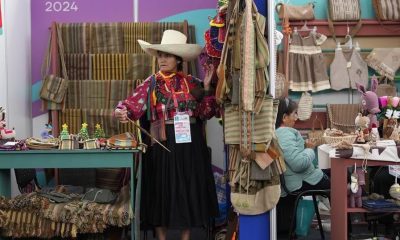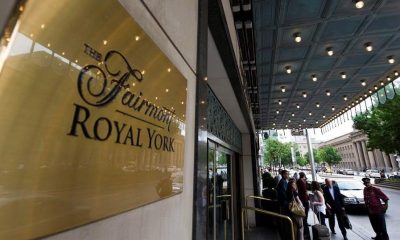Shirin Neshat, installation view of Woman. Life. Freedom. on Piccadilly Lights, London, 2022. © Shirin Neshat. © CIRCA. Photo by Clover Green Studio. Courtesy of the artist and CIRCA.
This past year has seen artists from around the world respond to the geopolitical realities of our tumultuous times through public art. From experiential, multi-site projects to performance-based interventions, these works not only challenge expectations of what public art can look like, but also reflect and confront the legacy of historical injustices.
To honor the immense currency of public art and its ability to move and influence those outside of institutional spaces, the art and design fabrication company UAP has revealed its seventh annual list of the best public art projects of the year.
The works featured in the 2022 edition were selected by leading industry figures Aric Chen, general and artistic director at Het Nieuwe Instituut; Tandazani Dhlakama, assistant curator at Zeitz MOCAA; Luise Faurschou, founder and CEO of Art2030; and Xiaoyu Weng, Carol and Morton Rapp Curator and Head of Modern and Contemporary Art at Art Gallery of Ontario; as well as UAP’s curatorial director Natasha Smith and senior curator Ineke Dane.
Below, we share the 2022 list, with reflections from the nominators on what makes these public artworks so urgent and compelling.
Hew Locke, Foreign Exchange
Victoria Square, Birmingham, England
Hew Locke, installation view of Foreign Exchange at Victoria Square in Birmingham, England, 2022. Presented by the Birmingham 2022 Festival and commissioned by Ikon. Photo by Shaun Fellows. Courtesy of Birmingham 2022 Festival and Ikon.
Coinciding with Birmingham’s hosting of the 2022 Commonwealth Games, a vestige of the British Empire, Guyanese British artist Hew Locke transformed the city’s 1901 statue of Queen Victoria into a crated figure placed on a boat among several replicas of the same statue. Called Foreign Exchange, the work evokes how the statue of the queen, and the empire she represented, were shipped around the world. As we rightly reconsider, and in some cases take down, monuments ennobling problematic figures and legacies, Locke acknowledges his “confused and complex” sentiments, adding nuance to the debate while still confronting it head-on.
—Aric Chen
Fujiko Nakaya, Munich Fog (Fogfall) #10865/II
Munich, Germany
Fujiko Nakaya, installation view of Munich Fog (Fogfall) #10865/II in “Nebel Leben” at Haus der Kunst, 2022. Photo by Andrea Rossetti. Courtesy of the artist and Haus der Kunst, Munich.
This outdoor fog sculpture, mounted on the side of Haus der Kunst in Munich, was remarkable as an announcement for “Fujiko Nakaya. Nebel Leben,” the major retrospective of the 89-year-old Japanese artist’s work with numerous other installations featured inside the institution. Part of the Experiments in Art and Technology (E.A.T.) collective that included John Cage, Robert Rauschenberg, and others in the 1960s, Nakaya made her first outdoor fog sculpture for the 1970 Osaka Expo and has been going strong ever since. She is relatively unsung in the West, but she is absolutely seminal—a true pioneer of phenomenological art who foreshadowed Olafur Eliasson and others by decades.
—Aric Chen
Thenjiwe Niki Nkosi, Equations for a Body at Rest
Birmingham, England
Thenjiwe Niki Nkosi, installation view of Equations for a Body at Rest in Birmingham, England, 2022. Courtesy of the artist and Eastside Projects.
Through her multi-site, multimedia project Equations for a Body at Rest, Johannesburg-based artist Thenjiwe Niki Nkosi offered us intriguing ways of thinking about imperialism and its contentious legacy. Using film, posters, and a reference website that was easily accessible through QR codes, she highlighted the spectacle, history, and contradictions of the Commonwealth Games. This was presented as part of the Birmingham 2022 Festival in the U.K. during the Commonwealth Games from July 6th to August 7th.
Nkosi’s critique took the form of three presentations, including The Name Game, a series of posters displayed at various billboard sites around Birmingham, and The Same Track, a film consisting of archival footage of previous Commonwealth Games screened in various public spaces. Nkosi intentionally removed the athletes from the film in order to draw attention to the performance and pageantry between the colonizer and the colonized, thus pointing to questions about the purpose and place of the Commonwealth from inception to today. The third element was the Equations for a Body at Rest reference website, which served as a gateway for further critical discourse and closer reading.
—Tandazani Dhlakama
The Female Association of Photographers and Artists in Mali, Sotrama Photo
Bamako, Mali
The Female Association of Photographers and Artists in Mali, Sotrama Photo, 2022. Courtesy of the Female Association of Photographers and Artists in Mali.
The Female Association of Photographers and Artists in Mali, Sotrama Photo, 2022. Courtesy of the Female Association of Photographers and Artists in Mali.
A sotrama is a means of public transportation in Mali. They are often green vans or minibuses that carry passengers on fixed routes around the city. In addition to the driver, sotramas often have touts who collect fares and give information about the journey, mediating between the driver and passengers. This year, the Female Association of Photographers and Artists in Mali initiated Sotrama Photo, which transformed a sotrama into a mobile photography studio.
In Bamako, Sotrama Photo offered diverse audiences the opportunity to engage with photography and share stories on their daily commute. The president of the association, artist Fatoumata Diabaté, said she felt compelled to interact with people, “huddled together in the languor of the day…pressed between hope and discouragement.” Passengers were urged to pose for a photo, engage with existing photographs of other passengers, and have dialogue about the issues of the day. In this case, the tout was an actor who interrupted the dreariness of the day by encouraging discussion and enabling commuters to laugh, reflect, and participate in various ways.
However, Sotrama Photo did not just end there. The vehicles had strategic stops in key neighborhoods where the association would host film screenings and have community discussions about important issues. The photographs from the sotramas were later presented at NEGPOS Gallery in France and in several locations in Mali. The association’s vision is to develop the photography sector in Mali and to strengthen the place of women in the cultural sector in general and in photography in particular, and they continue to do just that in poignant ways.
—Tandazani Dhlakama
Shirin Neshat, Woman. Life. Freedom.
London, England; Los Angeles, California
Shirin Neshat, installation view of Woman. Life. Freedom. on Piccadilly Lights, London, 2022. © Shirin Neshat. © CIRCA. Photo by Clover Green Studio. Courtesy of the artist and CIRCA.
On September 16th, Masha Amini, a 22-year-old Iranian woman, died after being detained by Iran’s so-called “morality police” on charges of improperly wearing her hijab. The news of her death while in state custody was met with outrage throughout the country and beyond, prompting protesters to take to the streets.
This work from Shirin Neshat is an urgent public commission that embodies the Iranian fight for freedom and basic human rights. Broadcast from October 1st through 4th across Piccadilly Circus in London and Pendry West Hollywood in Los Angeles, the work serves as a powerful accompaniment to the slogan being voiced across Iran: “Woman. Life. Freedom.”
Through a combination of urgency and care, Neshat selected two pivotal works from her “Women of Allah” series (1993–97) entitled Moon Song and Unveiling. In a statement on the piece, Neshat said, “For me, the meaning of the text and the bullets [in Moon Song] suggests the modern and contemporary reality of Iran, while the paisley and other floral motifs are symbolic of Iran’s rich ancient Persian history.”
The current humanitarian crisis in Iran affects us all. Any fight for justice, and any protest to protect women’s rights, impacts our global community. With Woman. Life. Freedom., Neshat encapsulates feelings of defiance and hope that resonate with her strongly at the moment. But most importantly, the artist evokes the idea of solidarity, inviting people around the world to further echo the rallying cries of Iranians for freedom.
—Luise Faurschou
Tino Sehgal, Special Project in Piazza Maggiore, Bologna for Art City Bologna 2022
Bologna, Italy
Portrait of Tino Sehgal in Piazza Maggiore on the occasion of ART CITY Bologna 2022. Photo by Ornella De Carlo. Courtesy of MAMbo – Museo d’Arte Moderna di Bologna.
Portrait of Tino Sehgal in Piazza Maggiore on the occasion of ART CITY Bologna 2022. Photo by Ornella De Carlo. Courtesy of MAMbo – Museo d’Arte Moderna di Bologna.
Tino Sehgal’s critical acclaim derives from his radical artistic practice that takes the form of “constructed situations”: live encounters between visitors and those enacting the work. Like no other, Sehgal rearticulates art spaces as a ritualistic environment of social interactions. Thus, the conventional subject-object relation is challenged and redirected into a fleeting production of implication, engagement, connection, and belonging.
The site-specific intervention that Sehgal conceived for Piazza Maggiore—for centuries a place of meeting and exchange, surrounded by medieval palaces and the imposing Basilica of San Petronio—saw the participation of 45 dancers and performers. Their bodies and gestures were used as an artistic and human material to transform the iconic square into an open-air museum, engaging visitors and passersby in a social experience of mutual exchange.
The fact that Sehgal’s works are produced in this way elicits a different kind of viewer: A visitor is no longer only a passive spectator but one who bears a responsibility to shape and contribute. His works may ask visitors what they think, but more importantly, they underscore an individual’s own agency in the museum environment.
—Luise Faurschou
Charles Gaines, Moving Chains
Governors Island, New York
Charles Gaines, installation of Moving Chains on Governors Island, 2022. Photo by Timothy Schenck. Courtesy of the artist, Governors Island Arts, Creative Time, and Time Square Arts.
A monumental kinetic installation by Los Angeles–based conceptual artist Charles Gaines, Moving Chains features nine rows of custom-made steel chains, continuously rolling atop of a wooden structure resembling a ship’s hull. Situated on New York’s Governors Island, along the waterway of the New York Harbor, the installation is a powerful commentary and critique of the history of slavery and systematic violence inherent within racial capitalism and foundational to the United States.
The moving speed of eight of the chains matches the harbor’s currents, while the rusty ninth chain in the middle travels faster than the rest to resemble the boat traffic in the city’s waterway—which, since the early colonial occupations, had become a significant site for the transatlantic slave trade.
Facing the Statue of Liberty, the symbolic power of the chain brings out contradiction and complexity as it mirrors the broken shackle and chain on Lady Liberty’s right foot—a representation of abolitionism. Walking through the body of the ship, the loud and rhythmic noises of the rolling chains engulf visitors from above, reminding us that the weight of history cannot and will not be silenced.
As one of the artist’s first public art commissions, Moving Chains took Gaines—who is best known for his grid and number-based drawings—eight years to realize due to numerous funding and engineering challenges, as well as the COVID-19 pandemic. As part of a three-chapter public art series titled “The American Manifest,” Moving Chains is one of the most powerful public artworks presented this year.
—Xiayou Weng
Brian Jungen, Couch Monster: Sadzěʔyaaghęhch’ill
Toronto, Canada
Brian Jungen, installation view of Couch Monster: Sadzěʔ yaaghęhch’ill at the Art Gallery of Ontario, 2022. © Brian Jungen. Courtesy of the artist and the Art Gallery of Ontario.
Revealed in June on the intersection of Dundas and McCaul Streets in the Canadian city of Toronto, Couch Monster: Sadzěʔyaaghęhch’ill is a bronze sculpture in the shape of a circus elephant assembled from cut-up leather couches. The casted surface of the leather sofas is hyperrealistic, conjuring the leathery texture of an elephant’s skin. This public art project by artist Brian Jungen began with the story of Jumbo, a captive circus elephant who made international headlines when it was hit and killed by a train in St. Thomas, Ontario, in 1885.
The inspiration to use cut-up furniture as his medium first came to Jungen when he was visiting Toronto in 2017 after seeing discarded furniture on the city’s streets. Juxtaposing different materials, textures, and subject matter, Jungen connects the misfortunes of large wild animals who have been caged, used, and often tortured by humans for entertainment with the destiny of home goods that were once luxurious and status-elevating but now torn apart—evoking empathy through the engagement of familiar everyday surroundings.
The work’s subtitle, in the Dane-zaa language of Jungen’s Indigenous heritage, translates to “My heart is ripping.” When Jungen asked elders in his community what they thought of circus elephants, they didn’t recall ideas of joy but how the animals’ “spirit had been broken” by their captors.
Jungen’s elephant seems to be performing a stunt of standing on a ball: Its four feet can barely fit and balance. What’s underneath the playful appearance of Couch Monster begs the difficult yet necessary reflection on humanity’s cruelty. The history of violence, control, and imprisonment goes much beyond Jumbo’s tragedy, as witnessed in colonialism and slavery. Commissioned by Kitty Scott, the Art Gallery of Ontario’s former Carol and Morton Rapp Curator of Modern and Contemporary Art, the work took Jungen five years to complete and is now part of the institution’s permanent collection.
—Xiayou Weng
Judy Watson, bara
Sydney, Australia
Judy Watson, installation of bara in Sydney, Australia, 2022. Photo by Document Photography. Courtesy of the artist UAP | Urban Art Projects.
Judy Watson’s matrilineal family is from Waanyi country in northwest Queensland, Australia. Her oeuvre—which includes painting, printmaking, drawing, sculpture, and video—is inspired by Aboriginal history and culture. The artist is often concerned with collective memory, using archival documents to unveil institutionalized discrimination against Aboriginal people and hidden histories of Australia’s past.
In May, the internationally recognized First Nations artist unveiled a new work, bara, at a headland ceremony overlooking Sydney Harbour, on the Tarpeian Precinct Lawn above Dubbagullee (Bennelong Point). Featuring a monumental bara, which are the fishhooks crafted and wielded by Gadigal women for thousands of generations, the work celebrates the First Peoples of Sydney—the traditional custodians of Gadigal Country—and honors clans of the Eora Nation. In the harbor, women fished from their nawis (canoes), hauling in catches with bara tied with carrejun or carrahjun (bush string) to cook on open fires.
Watson worked with local Elders, Uncle Allen and Charles “Chicka” Madden, in developing her concept and collaborated with UAP in the design, fabrication, and installation of the work. Her use of marble poetically subverts a traditionally colonial material to represent a new monument to First Nations people. Its gleaming finish is reminiscent of local seashells and exquisitely echoes the brilliant, tiled surface of the Sydney Opera House while reflecting the moon by night. And its crescent shape reflects the shapes of the moon, the coves of the harbor, the forms of the Sydney Opera House, and the arch of the Harbour Bridge.
Of the work, Watson said, “bara reimagines ancient gathering spaces where people sat by fires on the headlands and feasted.’’ Hetti Perkins, curatorial advisor to the Eora Journey, stated that “bara emerges out of an ancient and enduring Eora cultural context to eloquently express the nexus between the political, social, and natural landscapes of historical and contemporary Sydney.’’
—Natasha Smith and Ineke Dane
Richard Bell, Pay the Rent (Australia)
Kassel, Germany
Richard Bell, installation view of Pay the Rent at Fridericianum, Kassel, 2022. Courtesy of the artist; Milani Gallery, Meanjin / Brisbane; and Documenta.
Installed in arguably the most high-profile position at this year’s Documenta 15, Aboriginal artist Richard Bell’s Pay the Rent (Australia) was unmissable atop the Fridericianum’s façade in Kassel. The work was a long, black digital sign displaying a bright red, impossibly long figure that increased exponentially by the second. Calculated in real time using an algorithm embedded with compound interest and inflation, it represents the amount of debt owed to Aboriginal people by the Australian government since the federation of Australia in 1901.
Jakarta-based artist collective ruangrupa curated Bell’s work into Documenta 15, the preeminent quinquennial showcase of international art. As this edition’s artistic directors, ruangrupa built the foundation of Documenta 15 on the core values and ideas of the lumbung—the Indonesian term for a communal rice barn. Pay the Rent (Australia) sang in chorus with the lumbung artistic and economic model, rooted in principles of collective and equal allocation, and asked how the status quo in Australia might look different with a radical shift in perspective.
While Bell has said he doesn’t mean for the work to be taken too literally (because a dollar figure would never truly compensate for over a century of genocide and cultural oppression), he hopes it raises urgent discussions about the exploitation of Aboriginal people and emphasizes that Australia “is still our country. It always was, always will be Aboriginal land.” Pay the Rent (Australia) is a siren to the legacy of colonial projects worldwide and those who continue to benefit from these today.
—Natasha Smith and Ineke Dane
Source link
Related

































